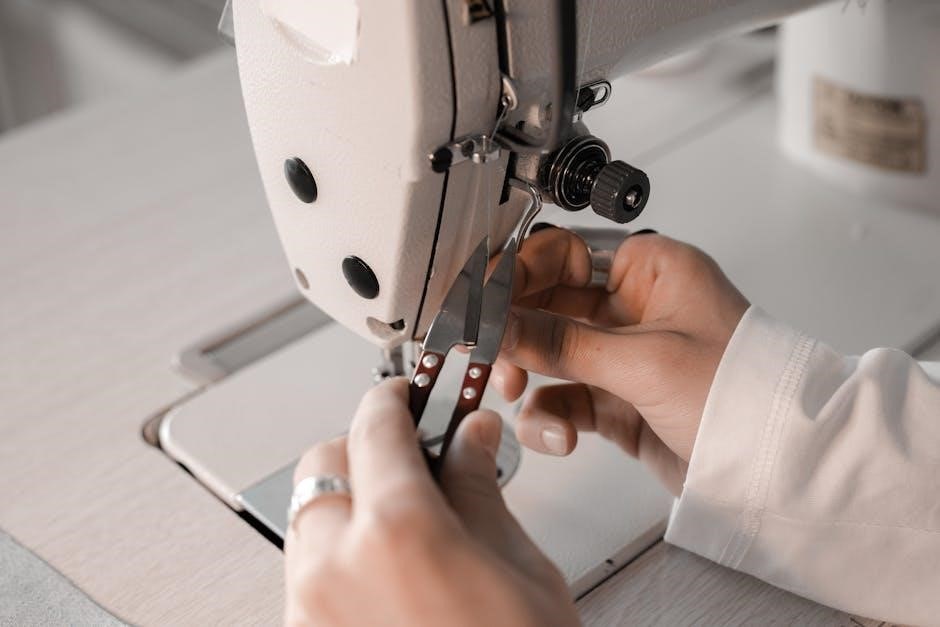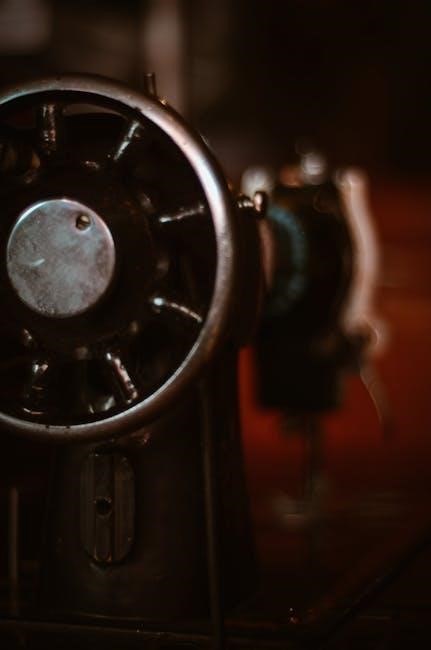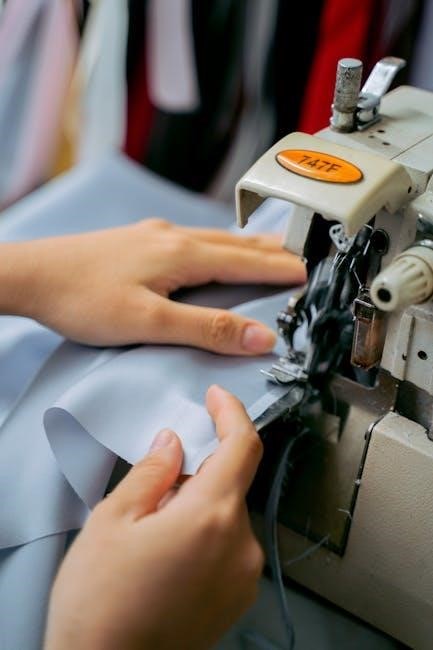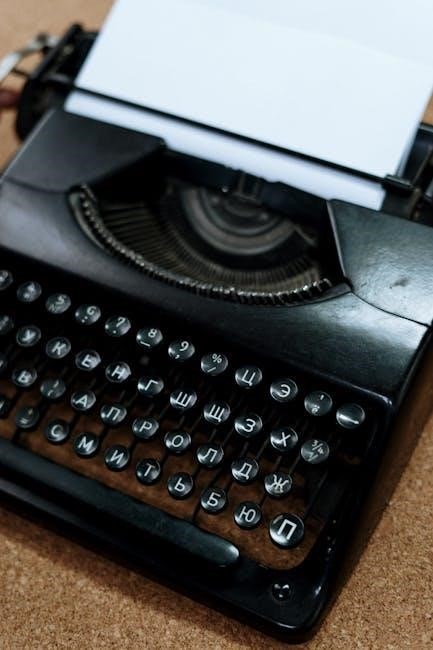Manual bottle filling machines offer a simple, versatile solution for various industries․ They provide cost-effective, precise filling for small-scale productions, ensuring efficiency and ease of operation․
1․1 What is a Manual Bottle Filling Machine?
A manual bottle filling machine is a device designed to fill bottles with precise volumes of liquid or paste․ It operates without automation, relying on manual control for starting and stopping the filling process․ These machines are cost-effective, portable, and ideal for small-scale productions or businesses with limited budgets․ They are commonly used for filling various products such as water, oil, shampoo, and food sauces․ Manual machines are simple to use, requiring minimal training, and are often preferred for their ease of maintenance and versatility in handling different bottle sizes and shapes․ Their compact design makes them suitable for laboratories, small manufacturing units, and even home-based businesses․
1․2 Basic Operation of a Manual Bottle Filling Machine
The basic operation of a manual bottle filling machine involves simple, user-controlled steps․ The machine typically includes a filling chamber, a control valve, and an outlet for dispensing the liquid․ To begin, the user pours the liquid into the chamber and selects the desired volume using an adjustable scale or dial․ Once set, the user places the bottle under the outlet and activates the filling process by opening the valve․ The machine then dispenses the precise amount of liquid into the bottle․ After filling, the valve is closed, and the bottle is removed․ This manual process ensures accuracy and is often equipped with anti-drip features to prevent spillage․ Regular cleaning and maintenance are essential to maintain efficiency and hygiene․

Types of Manual Bottle Filling Machines

Manual bottle filling machines are primarily categorized into volumetric and piston-based systems․ Volumetric machines measure liquid volume, while piston-based machines use a piston for precise filling․
2․1 Volumetric Filling Machines
Volumetric filling machines measure liquid based on volume, ensuring accurate fills․ They are ideal for various liquids, from thin beverages to thick pastes, and are widely used in food, cosmetic, and pharmaceutical industries․ These machines often feature adjustable settings to accommodate different bottle sizes and fill levels․ Their simplicity and portability make them a popular choice for small-scale productions․ Easy to clean and maintain, volumetric fillers are versatile, efficient, and cost-effective, making them a preferred option for businesses needing precise control over filling volumes․
2․2 Piston-Based Filling Machines
Piston-based filling machines operate by using a piston to draw and dispense a specific volume of liquid․ They are known for their high accuracy and suitability for both thin and thick liquids․ These machines often feature adjustable piston strokes, allowing users to customize fill levels․ The piston mechanism ensures minimal waste and precise control, making them ideal for viscous products like creams, gels, and sauces․ Additionally, they are equipped with check valves to prevent dripping and overflow․ Piston-based fillers are widely used in the pharmaceutical, cosmetic, and food industries due to their reliability and ease of cleaning․ Their durable design and consistent performance make them a popular choice for manual bottle filling needs․

Advantages of Manual Bottle Filling Machines
Manual bottle filling machines are cost-effective, portable, and easy to use․ They offer precise control, minimal setup, and low maintenance, ideal for small-scale operations and flexible needs․
3․1 Cost-Effectiveness
Manual bottle filling machines are highly cost-effective, requiring minimal investment for purchase and maintenance․ Their simple design ensures low operational costs, making them ideal for small businesses or startups․ With no need for advanced automation or complex systems, these machines reduce initial capital expenditure․ Additionally, their portability and ease of use allow for efficient operation without requiring specialized labor, further reducing expenses․ This affordability makes manual filling machines accessible to a wide range of industries, including food, beverage, and cosmetic sectors․ Their cost-effectiveness is a key advantage for businesses aiming to optimize their budget while maintaining reliable production processes․ This makes them a practical choice for many applications․
3․2 Ease of Use and Portability
Manual bottle filling machines are designed for simplicity, making them incredibly easy to operate․ They require minimal training, allowing users to fill bottles accurately and efficiently․ Their lightweight and compact design enhances portability, enabling easy transportation between workstations or locations․ This feature is particularly beneficial for small-scale productions or mobile operations․ Additionally, manual machines often have fewer components compared to automatic systems, reducing the complexity of operation and maintenance․ Their straightforward functionality makes them accessible to a wide range of users, from hobbyists to small business owners․ This ease of use and portability ensures that manual bottle filling machines remain a practical choice for various applications, including food, beverage, and cosmetic industries․

Applications of Manual Bottle Filling Machines
Manual bottle filling machines are widely used in the food, beverage, pharmaceutical, and cosmetic industries․ They are ideal for small-scale productions and versatile for various liquids and pastes․
4․1 Food and Beverage Industry
In the food and beverage sector, manual bottle filling machines are essential for small-scale productions, such as craft breweries and wineries․ They offer precise control for filling liquids like wine, oil, and sauces, ensuring consistency and quality․ Their portability and ease of use make them ideal for start-ups or businesses with limited production needs․ Additionally, these machines can handle various viscosity levels, from thin liquids to thicker condiments, making them versatile for different applications․ Their ability to maintain hygiene and prevent contamination is crucial in food safety standards, ensuring products remain fresh and safe for consumption․
4․2 Pharmaceutical and Cosmetic Industry
Manual bottle filling machines are widely used in the pharmaceutical and cosmetic industries for small-scale production․ They are ideal for filling precise amounts of liquids, gels, and creams into bottles, ensuring accuracy and hygiene․ These machines are particularly useful for products requiring strict quality control, such as ointments, serums, and lotions․ Their portability and ease of operation make them suitable for laboratory settings or small production facilities․ Additionally, they can handle various viscosities, from thin liquids to thick pastes, making them versatile for diverse applications․ The ability to maintain sterility and prevent contamination is crucial in these industries, ensuring products meet high safety and regulatory standards․

How to Choose the Right Manual Bottle Filling Machine
Selecting the right machine involves considering factors like filling accuracy, capacity, and compatibility with your product type to ensure efficient and precise bottle filling operations․
5․1 Factors to Consider
Selecting the right manual bottle filling machine requires evaluating several factors․ First, consider the type of liquid or paste being filled, as some machines are designed for specific viscosities․ Next, assess the required filling range and accuracy to ensure precision․ The machine’s build quality and durability are also crucial, especially for frequent use; Additionally, think about the ease of cleaning and maintenance, as this impacts long-term efficiency․ Portability and space requirements should also be evaluated, particularly for smaller operations․ Finally, budget constraints play a significant role in determining the appropriate model․ By carefully weighing these factors, you can choose a machine that meets your specific needs effectively․
5․2 Capacity and Filling Accuracy
When selecting a manual bottle filling machine, it’s crucial to evaluate its capacity and filling accuracy․ Capacity refers to the amount of liquid the machine can handle in one operation, while accuracy ensures precise filling volumes․ For small-scale operations, a machine with a smaller capacity and adjustable filling range may suffice․ However, for higher demand, machines with larger hoppers and consistent output are more efficient․ Accuracy is vital to prevent waste and ensure uniformity in bottle filling․ Look for machines with anti-drip features and precise measurement controls․ Assessing your specific needs helps balance capacity and accuracy, ensuring optimal performance․ Always consider the viscosity of the liquid, as this impacts both capacity and filling precision․ A well-matched machine will enhance productivity and reduce operational errors․

Maintenance and Troubleshooting
Regular cleaning and lubrication of moving parts ensure smooth operation․ Check for worn seals or misaligned nozzles, addressing leaks promptly․ Troubleshoot filling inaccuracies by adjusting settings or replacing worn components․
6․1 Regular Maintenance Tips
Regular maintenance ensures optimal performance and longevity of manual bottle filling machines․ Start by cleaning the machine thoroughly after each use to prevent residue buildup․ Lubricate moving parts periodically to reduce friction and wear․ Inspect and replace worn seals or gaskets to avoid leaks․ Check the alignment of nozzles and filling heads to maintain accuracy․ Drain and flush the system with clean water, especially when changing liquids․ Store the machine in a dry, cool place when not in use․ Following these steps helps prevent breakdowns and ensures consistent filling accuracy, making maintenance a crucial part of machine care․
6․2 Common Issues and Solutions
Manual bottle filling machines can encounter issues like inconsistent filling, leaks, or clogged nozzles․ To address these, check for improper bottle alignment or incorrect filling settings․ Tighten loose connections and replace worn-out seals․ For clogs, clean nozzles with filtered water or a soft brush․ If the machine underfills or overfills, adjust the fill level or timing․ Regular lubrication of moving parts can prevent mechanical jams․ Ensure all components are securely fastened and aligned․ Refer to the user manual for specific troubleshooting steps․ Addressing these issues promptly enhances efficiency and ensures consistent performance, minimizing downtime and maintaining product quality․

Future Trends in Manual Bottle Filling Machines
Future trends include integration of smart technology and eco-friendly designs, enhancing efficiency and sustainability․ Machines may feature touchscreens, IoT connectivity, and recyclable materials for better performance and environmental impact․
7․1 Integration with Automation
The integration of automation into manual bottle filling machines is revolutionizing their functionality․ By incorporating smart technologies, these machines can now offer advanced features like touchscreens and IoT connectivity, enabling remote monitoring and control․ Automation enhances filling accuracy and efficiency, reducing human error and increasing production capacity․ For instance, automated sensors can detect bottle presence and adjust filling levels dynamically․ Additionally, automated data logging and reporting capabilities provide insights into production metrics, aiding in process optimization․ This blend of manual operation with automated features ensures scalability and adaptability across various industries, making manual bottle filling machines more versatile and future-ready․ As technology advances, the synergy between manual and automated systems is expected to drive innovation, offering users unparalleled convenience and performance․
7․2 Sustainability and Eco-Friendly Designs
Eco-friendly designs are becoming a priority in manual bottle filling machines, aligning with global sustainability goals․ Manufacturers are incorporating recyclable materials and energy-efficient components to minimize environmental impact․ These machines often feature low power consumption and reduced waste generation, appealing to environmentally conscious businesses․ Additionally, some models are designed for easy disassembly, facilitating recycling at the end of their lifecycle․ Innovations such as water-saving mechanisms and eco-mode operations further enhance their sustainability․ As industries seek greener solutions, manual bottle filling machines are evolving to meet these demands, offering users a balance between functionality and environmental responsibility․ This focus on sustainability ensures these machines remain relevant in an increasingly eco-conscious market․
